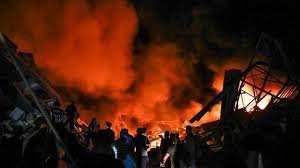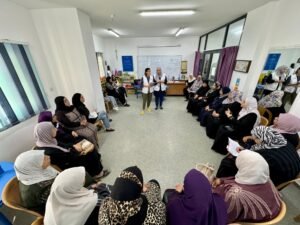‘Many more to die’ from Gaza siege, UN warns on day 21 of war

The UN warned Friday that “many more will die” in Gaza from catastrophic shortages after nearly three weeks of bombardment by Israel in response to Hamas staging the deadliest attack in its history.
As the conflict raged into its 21st day, the Israeli army said its soldiers backed by fighter jets and drones mounted a land incursion into the Gaza Strip, as it prepares for a ground offensive.
Concern is growing about regional fallout from the conflict, with the United States warning Iran against escalation while striking facilities in Syria it says were used by Iran’s Islamic Revolutionary Guard Corps and others.
Israel has heavily bombarded Gaza since Hamas gunmen stormed across the border on October 7, killing 1,400 people, mostly civilians, kidnapping more than 220 others, according to Israeli officials.
The health ministry in the Hamas-run Gaza Strip says the strikes have killed more than 7,000 people, mainly civilians and many of them children, leading to growing calls for protection of innocents caught up in the conflict.
“People in Gaza are dying, they are not only dying from bombs and strikes, soon many more will die from the consequences of (the) siege imposed on the Gaza Strip,” Philippe Lazzarini, head of the UN agency for Palestinian refugees (UNRWA), told reporters in Jerusalem.
Israel has cut supplies of food, water and power to Gaza, notably blocking all deliveries of fuel saying it would be exploited by Hamas to manufacture weapons and explosives.
“Basic services are crumbling, medicine is running out, food and water are running out, the streets of Gaza have started overflowing with sewage,” he said of the devastated territory where around 45 percent of all housing has been damaged or destroyed, according to the UN which cited local authorities.
- ‘Uninterrupted aid flow’ –
A first tranche of critically needed aid was allowed in at the weekend but since then only 74 trucks have crossed in via the Rafah border with Egypt, which aid agencies say is just a tiny fraction of what was needed.
Before the conflict, an average of 500 trucks entered Gaza every working day, UN figures show.
Gaza needed a “meaningful and uninterrupted aid flow” and a “humanitarian ceasefire to ensure this aid reaches those in need”, Lazzarini said, echoing a similar call by European Union leaders.
European Union leaders had on Thursday evening demanded “continued, rapid, safe and unhindered humanitarian access and aid to reach those in need through all necessary measures including humanitarian corridors and pauses for humanitarian needs”.
Between the bombardments and the fuel shortages, 12 of Gaza’s 35 hospitals have been forced to close, and UNRWA said it has had to “significantly reduce its operations”.
“What needs more support? Bakeries, water stations, life support machines in a hospital — all this needs fuel to function,” the head of the agency said on Friday.
The agency has so far had 57 staff killed since the war began, Lazzarini told journalists.
- ‘Our lives stopped’ –
With tens of thousands of Israeli troops massed along the Gaza border ahead of a widely expected ground offensive, the army said its forces had staged a ground incursion into central Gaza.
“We carried out a ground operation in central Gaza… as part of preparations for the coming stages of the war,” army spokesman Daniel Hagari told reporters, saying the number of hostages held by Hamas was now confirmed to be 229.
Black-and-white footage released by the military showed a column of armored vehicles as a thick cloud of dust billowed into the night sky after the strikes.
Tanks and infantry had staged a similar raid targeting the Islamist Hamas in northern Gaza the previous night, the army said.
Israel has won staunch backing from allies including the United States for its military action in Gaza, demanding Hamas release the more than 220 hostages it snatched on October 7 that include a mix of Israelis, foreigners and dual nationals.
The fate of the hostages remains a complicating factor for Israel’s planned ground operation.
Hamas’ armed wing said Thursday that “almost 50” hostages had been killed in the bombardments, in a claim that could not be independently verified.
- ‘Wherever we go, we will die’ –
Inside Gaza, the punishing strikes have left people “with nothing but impossible choices”, said Lynne Hastings, the UN’s humanitarian coordinator for the occupied Palestinian territory.
Israel has repeatedly urged civilians in northern Gaza to move south for their safety, but strikes have also hit southern areas and evacuation routes, with UN figures showing some 1.4 million people — more than half of Gaza’s population — have been displaced.
Heading the Israeli warnings, Rahma Saqallah fled her Gaza City home to go south with her family. But after strikes killed her husband and three of her children, she turned round to go back.
“Wherever we go, we will die,” she told AFP before leaving the southern town of Khan Yunis with her surviving child.
“They told us to leave for the south and then they killed us (here).”
Meanwhile, concern is growing over the regional fallout from the conflict, with Egypt’s army saying Friday six people were lightly injured when an “unidentified drone fell” on a town on the border with Israel.
The army said the drone crashed into “a building next to Taba hospital”, in the Red Sea town of the same name just across the border from the Israeli resort of Eilat.
Egypt’s AlQahera News television had said “a rocket” hit Taba, with witnesses telling AFP it struck a hospital annex in town, which lies 200 kilometers (124 miles) south of Egypt’s border with Gaza.
by Rosie Scammell with Adel Zaanoun in the Gaza Strip
©️ Agence France-Presse







